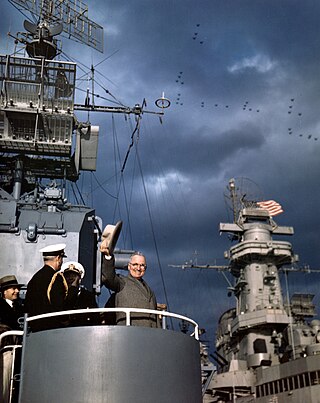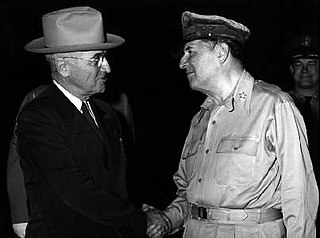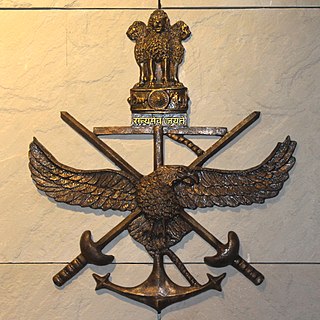
Military censorship is a type of censorship that is the process of keeping military intelligence and tactics confidential and away from the enemy. This is used to counter espionage. Military censorship intensifies during wartime. [1] [2] [3]

Military censorship is a type of censorship that is the process of keeping military intelligence and tactics confidential and away from the enemy. This is used to counter espionage. Military censorship intensifies during wartime. [1] [2] [3]
Military censorship existed in the United States since the time of the American Civil War. [4] [5] United States military in the 20th century defined military censorship as "all types of censorship conducted by personnel of the Armed Forces of the United States", and distinguished within it armed forces censorship, civil censorship, prisoner of war censorship and field press censorship. [6] [7]

The Armed Forces of Nigeria (AFN) are the military forces of Nigeria. The armed forces consists of three service branches: the Nigerian Army, Nigerian Navy, and Nigerian Air Force. The President of Nigeria functions as the commander-in-chief of the armed forces, exercising his constitutional authority directly or through the Ministry of Defence, which is responsible for the management of the military and its personnel. The president of Nigeria, as commander-in-chief also functions as the Admiral of the Fleet, for the Nigerian Navy, Marshal of the Airforce, for the Nigerian Airforce and Field Marshal for the Nigerian Army.

The Pakistan Armed Forces are the military forces of Pakistan. It is the world's sixth-largest military measured by active military personnel and consist of three formally uniformed services—the Army, Navy, and the Air Force, which are backed by several paramilitary forces such as the National Guard and the Civil Armed Forces. A critical component to the armed forces' structure is the Strategic Plans Division Force, which is responsible for the maintenance and safeguarding of Pakistan's tactical and strategic nuclear weapons stockpile and assets. The President of Pakistan is the Commander-in-Chief of the Pakistan Armed Forces and the chain of command is organized under the Chairman of the Joint Chiefs of Staff Committee (JCSC) alongside the respective Chiefs of staffs of the Army, Navy, and Air Force. All branches are systemically coordinated during joint operations and missions under the Joint Staff Headquarters (JSHQ).

The Armed Forces of the Philippines (AFP) are the military forces of the Philippines. It consists of three main service branches; the Army, the Air Force, and the Navy. The President of the Philippines is the Commander-in-Chief of the AFP and forms military policy with the Department of National Defense, an executive department acting as the principal organ by which military policy is carried out, while the Chief of Staff of the Armed Forces of the Philippines serves as the overall commander and the highest-ranking officer in the AFP.

The National Security Act of 1947 was a law enacting major restructuring of the United States government's military and intelligence agencies following World War II. The majority of the provisions of the act took effect on September 18, 1947, the day after the Senate confirmed James Forrestal as the first secretary of defense.
Military doctrine is the expression of how military forces contribute to campaigns, major operations, battles, and engagements. A military doctrine outlines what military means should be used, how forces should be structured, where forces should be deployed, and the modes of cooperation between types of forces. "Joint doctrine" refers to the doctrines shared and aligned by multinational forces or joint service operations.

In military operations, military reconnaissance or scouting is the exploration of an area by military forces to obtain information about enemy forces, the terrain, and civil activities in the area of operations. In military jargon, reconnaissance is abbreviated to recce and to recon, both derived from the root word reconnoitre.

The Joint Chiefs of Staff (JCS) is the body of the most senior uniformed leaders within the United States Department of Defense, which advises the president of the United States, the secretary of defense, the Homeland Security Council and the National Security Council on military matters. The composition of the Joint Chiefs of Staff is defined by statute and consists of a chairman (CJCS), a vice chairman (VJCS), the chiefs of the Army, Marine Corps, Navy, Air Force, Space Force, and the chief of the National Guard Bureau. Each of the individual service chiefs, outside their JCS obligations, works directly under the secretaries of their respective military departments, e.g. the secretary of the Army, the secretary of the Navy, and the secretary of the Air Force.

The chairman of the Joint Chiefs of Staff (CJCS) is the presiding officer of the Joint Chiefs of Staff (JCS). The chairman is the highest-ranking and most senior military officer in the United States Armed Forces and the principal military advisor to the president, the National Security Council, the Homeland Security Council, and the secretary of defense. While the chairman of the Joint Chiefs of Staff outranks all other commissioned officers, the chairman is prohibited by law from having operational command authority over the armed forces; however, the chairman assists the president and the secretary of defense in exercising their command functions.

The Combined Chiefs of Staff (CCS) was the supreme military staff for the United States and Britain during World War II. It set all the major policy decisions for the two nations, subject to the approvals of British Prime Minister Winston Churchill and U.S. President Franklin D. Roosevelt.

The "Revolt of the Admirals" was a policy and funding dispute within the United States government during the Cold War in 1949, involving a number of retired and active-duty United States Navy admirals. These included serving officers Admiral Louis E. Denfeld, Chief of Naval Operations, and Vice Admiral Gerald F. Bogan, as well as Fleet Admirals Chester Nimitz and William Halsey, senior officers during World War II.
An inspector general is an investigative official in a civil or military organization. The plural of the term is "inspectors general".
The Military Staff Committee (MSC) is the United Nations Security Council subsidiary body whose role, as defined by the United Nations Charter, is to plan UN military operations and assist in the regulation of armaments. Although the Military Staff Committee continues to exist, negotiation efforts between the United States, the Soviet Union and other nations in the late 1940s failed, and the committee has since been largely defunct, only serving in an advisory capacity.

Civilian control of the military is a doctrine in military and political science that places ultimate responsibility for a country's strategic decision-making in the hands of the civilian political leadership, rather than professional military officers.

The Tanzania People’s Defence Force (TPDF) is the military force of the United Republic of Tanzania. It was established in September 1964, following a mutiny by the former colonial military force, the Tanganyika Rifles. From its inception, it was ingrained in the troops of the new TPDF that they were a people's force under civilian control. Unlike some of its neighbouring countries, Tanzania has never suffered a coup d'état or civil war.

The Joint Chiefs of Staff Committee (JCSC), ; is an administrative body of senior high-ranking uniformed military leaders of the unified Pakistan Armed Forces who advises the civilian Government of Pakistan, National Security Council, Defence Minister, President and Prime minister of Pakistan on important military and non-military strategic matters. It is defined by statute, and consists of a Chairman, the military chiefs from Army, Navy and the Air Force: all four-star officers appointed by the President, on the advice of the Prime minister. The chairman is selected based on seniority and merit from the Chiefs of service of the three branches of the Pakistan Armed and Defense Services. Each service chief, outside their Joint Chiefs of Staff obligations, performs their duty directly for the Ministry of Defence.

Interservice rivalry is rivalry between different branches of a country's armed forces. This may include competition between land, marine, naval, coastal, air, or space forces.
General of the Air Force (GAF) is a five-star general officer rank and is the highest possible rank in the United States Air Force. General of the Air Force ranks immediately above a general and is equivalent to General of the Army in the United States Army and Fleet Admiral in the United States Navy. The rank has been held only once, by General Henry H. Arnold, who had served as head of the United States Army Air Forces during World War II.
Irregular warfare (IW) is defined in United States joint doctrine as "a violent struggle among state and non-state actors for legitimacy and influence over the relevant populations." In practice, control of institutions and infrastructure is also important. Concepts associated with irregular warfare are older than the term itself.

On 11 April 1951, U.S. president Harry S. Truman relieved General of the Army Douglas MacArthur of his commands after MacArthur made public statements that contradicted the administration's policies. MacArthur was a popular hero of World War II who was then commander of United Nations Command forces fighting in the Korean War, and his relief remains a controversial topic in the field of civil–military relations.

Integrated Theatre Commands of the Indian Armed Forces are varying degrees of synergy and cross–service cooperation between the military wings of the Indian Armed Forces. Following Independence, in 1949 a joint educational framework was set up starting with the first tri-service academy in the world, the National Defence Academy, and over the years this joint educational framework has been expanded to bring officers from the different services together at different stages of their careers.